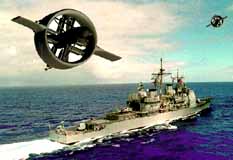| . |  |
. |
London - October, 26 1999 - We will never see it but the Earth has at least one other natural satellite. In discovering several new types of orbital motion, a team of British scientists has shown that the gravitational forces of our planet and of the Sun allow our planet to capture passing asteroids. One of them is named 'Cruithne', and can be considered -- at least for the next 5000 years -- as 'Earth's second Moon'. The work of coorbital dynamics by a team from Queen Mary and Westfield College in London was published 27 September in the US publication 'Physical Review Letters'. Fathi Namouni, Apostolos Christou and Carl Murray have taken even further the discoveries of Joseph-Louis Lagrange. The 18th century French mathematician gave his name to the five special points of equilibrium between the gravitational forces of a planet like our Earth and those of the Sun. The 'Lagrangian points' -- also known as libration points -- demonstrate the so-called 'three-body problem' when a planet and its Sun can catch a third companion (see diagram). The first point L1 is situated on a line between the planet and its Sun. SOHO, the ESA-NASA Solar and Heliospheric Observatory is the first spacecraft to exploit such a position. It is currently orbiting the inner L1 position 1.5 million km from Earth using this vantage point to study the Sun. L2 is on the same line but on the outer side from Earth. The L3 point is precisely on the other side of the Sun. L4 and L5 are at the summit of two equilateral triangles with a common base being the line between the Earth and the Sun. Joseph-Louis Lagrange had already shown that objects turning around L4 and L5 could easily stay there. This configuration applies to other planets of the solar system. Indeed Jupiter has hundreds of Trojan asteroids and Mars has at least two. Although Saturn itself has none, its own moons Tethys and Dione maintain Trojan asteroid satellites at Lagrangian points. The orbits of these third bodies are exotic. The Trojan asteroids describe a 'tadpole-shaped' pattern around the L4 and L5 points. Even more peculiar is the 'horseshoe orbit' in which the third body turns around the three points of equilibrium, L3, L4 and L5. Cruithne is such an object. Discovered in 1997, it is a 5-km diameter asteroid that takes 770 years to complete its horseshoe orbit. Thus every 385 years it comes to its closest point to Earth, some 15 million kilometres. Last time was in 1900, next -- if you can wait -- will be in 2285. The British team integrated Cruithne's parameters into their mathematical models, deducing that it can remain in its present state for 5,000 years before leaving. They have even calculated that 'Earth's second moon' is likely to be a second-comer having been trapped in a similar orbit some time in the past 100,000 years. "Cruithne is a case example, proof that our work is not just abstract calculations," says Carl Murray. "The mathematical model that we have developed has been able, not only to predict several new types of previously unsuspected motion, but has it has subsequently been confirmed by investigating numerically the orbits of real solar system objects. Nature has already provided examples of every kind of orbit that the theory can provide." Examining existing catalogues of near-Earth objects to see whether there were any other similar cases, the Queen Mary and Westfield College team have discovered four: three concerning Earth and one for Venus. The main significance of the work is that it provides a complete classification of coorbital motions. It could lead to a greater understanding of other asteroids, including their likelihood of hitting Earth and of how the planets were formed. Space mission planners could devise new gravitational tricks for their space probes. Murray himself is one of the European members of the Imaging Science Subsystem team on the Cassini orbiter part of the Cassini-Huygens mission. The team also shows that the forces of attraction in the three-body problem are also present in other domains of science -- such as chemistry where, for instance, two electrons of an atom of helium display a similar 'm�nage � trois' around their nucleus.
 Bowie Md - October 26, 1999 -
Bowie Md - October 26, 1999 - Altair Aerospace is pleased to announce the award of a contract from the Naval Air Systems Command to support Vertical Take-Off and Landing R&D activities. During the initial phase of this contract Altair will apply the state prediction capabilities of the company's Commercial-Off-The-Shelf control system product, the Altairis Mission Control System, to enable safe touchdown of the VTUAV on a moving ship deck. |
|
|
|
|
|
|
|
|
|
|
|
|
|
| The content herein, unless otherwise known to be public domain, are Copyright 1995-2006 - SpaceDaily.AFP and UPI Wire Stories are copyright Agence France-Presse and United Press International. ESA PortalReports are copyright European Space Agency. All NASA sourced material is public domain. Additionalcopyrights may apply in whole or part to other bona fide parties. Advertising does not imply endorsement,agreement or approval of any opinions, statements or information provided by SpaceDaily on any Web page published or hosted by SpaceDaily. Privacy Statement |